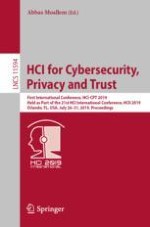2019 | OriginalPaper | Buchkapitel
Understanding Perceptions: User Responses to Browser Warning Messages
verfasst von : Heather Molyneaux, Irina Kondratova, Elizabeth Stobert
Erschienen in: HCI for Cybersecurity, Privacy and Trust
Aktivieren Sie unsere intelligente Suche, um passende Fachinhalte oder Patente zu finden.
Wählen Sie Textabschnitte aus um mit Künstlicher Intelligenz passenden Patente zu finden. powered by
Markieren Sie Textabschnitte, um KI-gestützt weitere passende Inhalte zu finden. powered by
